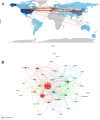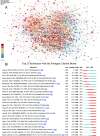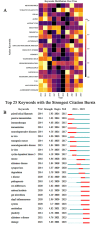Bibliometric analysis of pathological mechanisms in Alzheimer's disease: Applications based on mouse models
- PMID: 40822130
- PMCID: PMC12351105
- DOI: 10.1177/25424823251367046
Bibliometric analysis of pathological mechanisms in Alzheimer's disease: Applications based on mouse models
Abstract
Background: Alzheimer's disease (AD) is a progressive neurodegenerative disorder marked by memory loss and cognitive decline. Animal models play a key role in exploring its pathophysiological mechanisms.
Objective: To analyze global research trends and knowledge structure in AD pathophysiological mechanisms based on animal models.
Methods: Publications from 2014 to 2023 were retrieved from the Web of Science Core Collection. CiteSpace and VOSviewer were used for bibliometric analysis and data visualization.
Results: A total of 2169 publications were identified, with a steady growth trend. The United States and China were the leading contributors, with Harvard University as a major collaborative hub. The Journal of Alzheimer's Disease published the most articles, while the Journal of Neuroscience had the highest co-citation frequency. Holtzman DM was a key author in the field. Nine keyword clusters were identified, including insulin resistance, amyloid beta, and oxidative stress. Emerging topics include synapse loss, gut microbiota, and NLRP3 inflammasome.
Conclusions: This study provides a concise overview of global research on AD pathophysiological mechanisms in animal models, offering valuable insights for future research directions.
Keywords: Alzheimer's disease; animal model; bibliometrics; mice; pathology.
© The Author(s) 2025.
Conflict of interest statement
The authors declared no potential conflicts of interest with respect to the research, authorship, and/or publication of this article.
Figures









References
-
- Querfurth HW, LaFerla FM. Alzheimer’s disease. N Engl J Med 2010; 362: 329–344. - PubMed
-
- Santana I, Farinha F, Freitas S, et al. The epidemiology of dementia and Alzheimer disease in Portugal: estimations of prevalence and treatment-costs. Acta Med Port 2015; 28: 182–188. - PubMed
-
- Alzheimer’s Association . 2025 Alzheimer’s disease facts and figures. Alzheimers Dement 2025; 21: e70235.
-
- Duthey B. Background Paper 6.11: Alzheimer disease and other dementias, update on 2004. Geneva: World Health Organization, 2013.
Publication types
LinkOut - more resources
Full Text Sources

